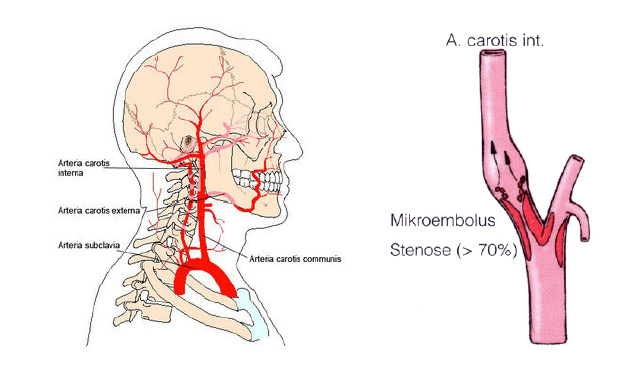
15 März 2022 Stenosis of the carotid artery caused by arteriosclerosis
TCD for diagnosis of Asymptomatic Carotid Stenosis
The term of carotid stenosis means a narrowing of the brain feeding common carotid artery (ACC) or internal carotid artery (ICA). Most commonly, stenosis of these vessels is caused by arteriosclerosis. If ACC or ICA entirely occludes, due to sclerosis and depending on collateralisation of the Circle of Willis this equates to cerebral stroke. Similarly, embolic material, which was scattered by sclerotic plaques, can cause stroke as well.
Carotid Stenosis
The term of carotid stenosis means a narrowing of the brain feeding common carotid artery (ACC) or internal carotid artery (ICA). Most commonly, stenosis of these vessels is caused by arteriosclerosis. If ACC or ICA entirely occludes, due to sclerosis and depending on collateralisation of the Circle of Willis this equates to cerebral stroke. Similarly, embolic material, which was scattered by sclerotic plaques, can cause stroke as well.
Arteriosclerotic plaques
Arteriosclerotic plaques develop from agglomeration of cholesterol, fatty acids, calcium and other organic compounds (like proteoglycans) within the vascular wall. Risk factors are: Hypercholesterolemia, hypertension, smoking, obesity, diabetes and positive family history.
In case of progressive plaque development, these plaques can rupture finally. The side of vascular plaques is certainly vulnerable for agglomeration of blood clots, which involves risks in two respects: (1) total luminal occlusion and (2) embolisation of clots into the brain. Both occlusion and embolisation can cause cerebral stroke.
Aetiology and incidence
Prevalence of carotid stenosis within the Caucasian population is in between 0-11% (Weerd et al., 2010). Due to higher prevalence of arteriosclerosis this rate increases in elderly population.
The following conclusion about incidence and prevalence of carotid stenosis is based on the German textbook: “Chirurgie” written by Siewert et al., 2006:
About 90% of ischemic strokes affect the brain area, which is supplied by carotid artery. About 20% of strokes are caused by extra-cranial carotid stenosis. In Germany, each year, about 30,000 people suffer from cerebral stroke.
However, not every stenosis causes stroke at all. ACS less than 80% carries a risk of 1-2% each year. Both increasing grade of stenosis and occurrence of neurological symptoms boost this risk. Stenosis higher than 80% carries a risk of 3-5%. Following transient ischemic attack (TIA) and grade of stenosis beyond 70%, about 40% of suffering patients develop stroke within a period of two years.
Diagnosis and treatment
Diagnosis of ACC stenosis can be made by auscultation (flow noise) and/or color-coded Duplex sonography (considered as gold standard in Germany). Theoretically, an indirect diagnosis by blood flow velocity measurement using TCD is possible as well. The NASCET trial demonstrated following correlation between flow velocity in ACC, ICA and grade of stenosis:

However, TCD offers its most important value in assessment of stroke risk in patients suffering from asymptomatic carotid stenosis.
Symptomatic carotid stenosis should always be treated therapeutically, but type of treatment of ACS is dependent on the individual risk to develop cerebral stroke.
- Elimination of risk factors
- Interventions/drugs:
- Anti-platelet therapy
- Thrombo-endarteriectomy
- Balloon dilatation and, if necessary, stenting
- Carotid bypass surgery
TCD benefit
Carotid stenosis can remain asymptomatic for a long time. As mentioned above, incidence of stroke is about 1% per anno in case of 80% or higher stenosis. However, therapeutic options underlie various interventional risks, which may exceed the risk of stroke (depending on type of intervention 3-10%). King et al. (2011) showed that 32 operations (thrombo-endarteriectomie) were necessary to avoid one disability or one death caused by stroke within an observation period of 5 years. ACAS trail, which was published in JAMA in 1995, demonstrated a NNT (= number needed to treat) of 67 to avoid one stroke within a two-year period.
These studies illustrate that a technique is necessary, which is able to find those patients suffering from ACS, who would most likely benefit from invasive interventions.
Telman et al. published in 2009 that plaque morphology alone is not an adequate predictor. However, occurrence of embolic TCD signal patterns was shown to be correlated with an increased risk of stroke development (Markus et al., 2010; Ritter et al., 2008; Spence et al., 2005).
King et al. (2011) postulated that emboli counting during 2 TCD monitoring examinations (each at least lasting 1 hour) is most suitable to predict risk of stroke caused by asymptomatic carotid stenosis.
Other literature: Herold Innere Medizin, 2011.

